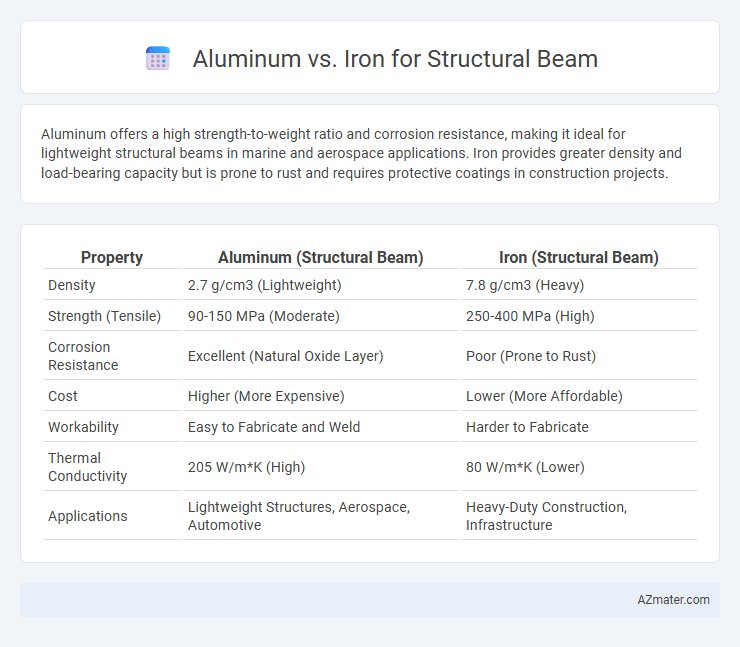Aluminum offers a high strength-to-weight ratio and corrosion resistance, making it ideal for lightweight structural beams in marine and aerospace applications. Iron provides greater density and load-bearing capacity but is prone to rust and requires protective coatings in construction projects.
Table of Comparison
| Property | Aluminum (Structural Beam) | Iron (Structural Beam) |
|---|---|---|
| Density | 2.7 g/cm3 (Lightweight) | 7.8 g/cm3 (Heavy) |
| Strength (Tensile) | 90-150 MPa (Moderate) | 250-400 MPa (High) |
| Corrosion Resistance | Excellent (Natural Oxide Layer) | Poor (Prone to Rust) |
| Cost | Higher (More Expensive) | Lower (More Affordable) |
| Workability | Easy to Fabricate and Weld | Harder to Fabricate |
| Thermal Conductivity | 205 W/m*K (High) | 80 W/m*K (Lower) |
| Applications | Lightweight Structures, Aerospace, Automotive | Heavy-Duty Construction, Infrastructure |
Overview: Aluminum vs Iron in Structural Engineering
Aluminum and iron are widely used materials in structural engineering, each offering distinct advantages based on their physical properties. Aluminum provides a high strength-to-weight ratio, corrosion resistance, and ease of fabrication, making it ideal for lightweight, durable structures. Iron, particularly in its steel form, offers superior tensile strength and load-bearing capacity, making it suitable for heavy-duty construction where maximum strength is essential.
Material Properties: Strength and Weight Comparison
Aluminum offers a high strength-to-weight ratio, making it significantly lighter than iron while maintaining adequate structural strength, which results in easier handling and reduced overall load on foundations. Iron, particularly cast iron or wrought iron, provides superior compressive strength and durability but is substantially heavier, leading to increased transportation and installation challenges. The choice between aluminum and iron for structural beams depends on balancing weight-sensitive applications favoring aluminum against heavy-load scenarios where iron's strength and stiffness are more beneficial.
Durability and Corrosion Resistance
Aluminum structural beams offer superior corrosion resistance due to their natural oxide layer, which prevents rust and extends lifespan in harsh environments. In contrast, iron beams are prone to rust and require protective coatings or treatments to maintain durability over time. While iron provides higher strength, aluminum's lightweight nature combined with its resistance to corrosion makes it ideal for applications demanding long-term exposure to moisture or chemicals.
Cost Analysis: Initial and Long-Term Expenses
Aluminum structural beams typically have higher initial costs due to material prices and fabrication processes but offer long-term savings through lower maintenance and corrosion resistance compared to iron. Iron beams, while more affordable upfront, often incur greater expenses over time because of rust protection, repairs, and shorter lifespan. Evaluating total cost of ownership, aluminum's durability and reduced upkeep make it a cost-effective choice for projects requiring longevity and minimal maintenance.
Load-Bearing Capacity and Structural Performance
Aluminum structural beams offer a high strength-to-weight ratio, making them ideal for applications where reducing weight is crucial without compromising load-bearing capacity. Iron beams, particularly those made from cast iron or wrought iron, provide superior compressive strength and durability, enabling them to support heavier loads in construction projects with minimal deformation. Despite aluminum's lower density, iron's higher modulus of elasticity generally results in better overall structural performance in heavy load-bearing scenarios.
Sustainability and Environmental Impact
Aluminum structural beams offer superior sustainability due to their high recyclability and lower density, which reduces transportation emissions and energy consumption during installation. Iron beams, primarily made of steel, have a higher carbon footprint resulting from intensive mining, smelting, and processing, contributing significantly to greenhouse gas emissions. The use of aluminum in construction promotes circular economy principles by enabling efficient material recovery and reuse, minimizing long-term environmental impact compared to traditional iron-based alternatives.
Fabrication and Installation Differences
Aluminum structural beams offer easier fabrication due to their lightweight nature, allowing for quicker cutting, welding, and handling compared to heavier iron beams that require more robust equipment and labor-intensive processes. Installation of aluminum beams benefits from reduced weight, which simplifies transportation and positioning, resulting in faster assembly and lower labor costs on-site. Iron beams, while stronger and more durable, demand more effort during installation due to their bulk and weight, necessitating cranes or heavy machinery for lifting and alignment.
Maintenance Requirements
Aluminum structural beams require less maintenance compared to iron due to their natural corrosion resistance and lightweight properties, reducing the need for frequent painting or rust treatments. Iron beams, while strong, are prone to rust and corrosion, necessitating regular inspections and protective coatings to ensure longevity. Choosing aluminum minimizes long-term maintenance costs and extends the structural lifespan in environments exposed to moisture or corrosive elements.
Common Applications in Construction
Aluminum structural beams are widely used in construction for lightweight frameworks, such as in commercial buildings, bridges, and roofing systems, where corrosion resistance and ease of handling are critical. Iron beams, specifically structural steel, dominate high-load bearing applications like skyscrapers, industrial warehouses, and heavy-duty infrastructure due to their superior strength and durability. The choice between aluminum and iron beams depends on factors including load requirements, environmental conditions, and project budget constraints.
Choosing the Right Material: Factors to Consider
Aluminum offers lightweight advantages and corrosion resistance, making it suitable for structures requiring easy handling and exposure to moisture, while iron provides superior strength and durability for heavy-load applications. Consider factors like load-bearing capacity, environmental conditions, cost, and maintenance demands when choosing between aluminum and iron for structural beams. The choice impacts project longevity, safety, and overall performance, emphasizing the need for precise material analysis aligned with structural requirements.

Infographic: Aluminum vs Iron for Structural Beam
 azmater.com
azmater.com